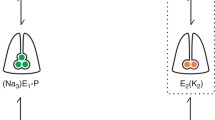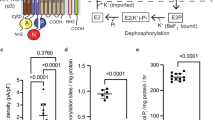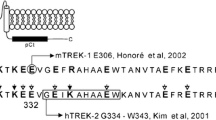Abstract
Sodium- and potassium-activated adenosine triphosphatases (Na,K-ATPase) is the ubiquitous active transport system that maintains the Na+ and K+ gradients across the plasma membrane by exchanging three intracellular Na+ ions against two extracellular K+ ions. In addition to the two cation binding sites homologous to the calcium site of sarcoplasmic and endoplasmic reticulum calcium ATPase and which are alternatively occupied by Na+ and K+ ions, a third Na+-specific site is located close to transmembrane domains 5, 6 and 9, and mutations close to this site induce marked alterations of the voltage-dependent release of Na+ to the extracellular side. In the absence of extracellular Na+ and K+, Na,K-ATPase carries an acidic pH-activated, ouabain-sensitive “leak” current. We investigated the relationship between the third Na+ binding site and the pH-activated current. The decrease (in E961A, T814A and Y778F mutants) or the increase (in G813A mutant) of the voltage-dependent extracellular Na+ affinity was paralleled by a decrease or an increase in the pH-activated current, respectively. Moreover, replacing E961 with oxygen-containing side chain residues such as glutamine or aspartate had little effect on the voltage-dependent affinity for extracellular Na+ and produced only small effects on the pH-activated current. Our results suggest that extracellular protons and Na+ ions share a high field access channel between the extracellular solution and the third Na+ binding site.







Similar content being viewed by others
References
Apell H.-J., Karlish S.J.D. 2001. Functional properties of Na,K-ATPase, and their structural implications, as detected with biophysical techniques. J. Membr. Biol. 180:1–9
Efthymiadis A., Rettinger J., Schwarz W. 1993. Inward-directed current generated by the Na+,K+ pump in Na+- and K+-free medium. Cell Biol. Int. 17:1107–1116
Feng J.N., Lingrel J.B. 1995. Functional consequences of substitutions of the carboxyl residue glutamate 779 of the Na,K-ATPase. Cell. Mol. Biol. Res. 41:29–37
Gadsby D.C., Rakowski R.F., De Weer P. 1993. Extracellular access to the Na,K pump: Pathway similar to ion channel. Science 260:100–103
Geering K., 2001. The functional role of beta subunits in oligomeric P-type ATPases. J. Bioenerg. Biomembr. 33:425–438
Geering K., Beggah A., Good P., Girardet S., Roy S., Schaer D., Jaunin P. 1996. Oligomerization and maturation of Na,K-ATPase - Functional interaction of the cytoplasmic NH2 terminus of the beta subunit with the alpha subunit. J. Cell Biol. 133:1193–1204
Girardet M., Geering K., Frantes J.M., Geser D., Rossier B.C., Kraehenbühl J.-P. 1981. Immunochemical evidence for a transmembrane orientation of both the Na+,K+-ATPase subunits. Biochemistry 20:6684–6691
Hakansson K.O., Jorgensen P.L. 2003. Homology modeling of Na,K-ATPase - A putative third sodium binding site suggests a relay mechanism compatible with the electrogenic profile of Na+ translocation. Na,K-ATPase Relat. Cation Pumps 986:163–167
Hilgemann D.W. 1994. Channel-like function of the Na,K pump probed at microsecond resolution in giant membrane patches. Science 263:1429–1432
Horisberger J.-D. 2004. Recent insights into the structure and mechanism of the sodium pump. Physiology 19:377–387
Horisberger J.-D., Kharoubi-Hess S. 2002. Functional differences between α subunit isoforms of the rat Na,K-ATPase expressed in Xenopus oocytes. J. Physiol. 539:669–680
Horisberger J.-D., Kharoubi-Hess S., Guennoun S., Michielin O. 2004. The 4th transmembrane segment of the Na,K-ATPase α subunit: A systematic mutagenesis study. J. Biol. Chem. 279:29542–29550
Jaisser F., Jaunin P., Geering K., Rossier B.C., Horisberger J.-D. 1994. Modulation of the Na,K-pump function by the β-subunit isoforms. J. Gen. Physiol. 103:605–623
Jewell-Motz E.A., Lingrel J.B. 1993. Site-directed mutagenesis of the Na,K-ATPase: Consequences of substitutions of negatively-charged amino acids localized in the transmembrane domains. Biochemistry 32:13523–13530
Jorgensen P.L., Hakansson K.O., Karlish S.J.D. 2003. Structure and mechanism of Na,K-ATPase: Functional sites and their interactions. Annu. Rev. Physiol. 65:817–849
Läuger, P., 1991. Na,K-ATPase. In: Electronic Ion Pumps, Sinauer Associates, Sunderland, MA 168–225
Li C., Capendeguy O., Geering K., Horisberger J.-D. 2005. A third Na+ binding site in the sodium pump. Proc. Natl. Acad. Sci. USA 102:12706–12711
Melton D.A., Krieg P.A., Rebagliati M.R., Maniatis T., Zinn K., Green M.R. 1984. Efficient in vitro synthesis of biologically active RNA and RNA hybridization probes from plasmids containing a bacteriophage SP6 promoter. Nucleic Acids Res. 12:7035–7056
Nagle J.F., Morowitz H.J. 1978. Molecular mechanisms for proton transport in membranes. Proc. Natl. Acad. Sci. USA 75:298–302
Nelson R.M., Long G.L. 1989. A general method of site-specific mutagenesis using a modification of the Thermus aquaticus polymerase chain reaction. Anal. Biochem. 180:147–151
Ogawa H., Toyoshima C. 2002. Homology modeling of the cation binding sites of the Na+K+-ATPase. Proc. Natl. Acad. Sci. USA 99:15977–15982
Pomes R., Roux B. 2002. Molecular mechanism of H+ conduction in the single-file water chain of the gramicidin channel. Biophys. J. 82:2304–2316
Post R.L., Jolly P.C. 1957. The linkage of sodium, potassium, and ammonium active transport across the human erythrocyte membrane. Biochim. Biophys. Acta 25:118–128
Rakowski R.F., Vasilets L.A., LaTona J., Schwarz W. 1991. A negative slope in the current-voltage relationship of the Na+/K+ pump in Xenopus oocytes produced by reduction of external [K+]. J. Membr. Biol. 121:177–187
Rettinger J. 1996. Characteristics of Na+/K+-ATPase mediated proton current in Na+- and K+-free extracellular solutions - Indications for kinetic similarities between H+/K+-ATPase and Na+/K+-ATPase. Biochim. Biophys. Acta 1282:207–215
Sweadner K.J., Donnet C. 2001. Structural similarities of Na,K-ATPase and SERCA, the Ca2+-ATPase of the sarcoplasmic reticulum. Biochem. J. 356:685–704
Toyoshima C., Mizutani T. 2004. Crystal structure of the calcium pump with a bound ATP analogue. Nature 430:529–535
Toyoshima C., Nakasako M., Nomura H., Ogawa H. 2000. Crystal structure of the calcium pump of sarcoplasmic reticulum at 2.6 A resolution. Nature 405:647–655
Toyoshima C., Nomura H. 2002. Structural changes in the calcium pump accompanying the dissociation of calcium. Nature 418:605–611
Van Huysse J.W., Jewell E.A., Lingrel J.B. 1993. Site-directed mutagenesis of a predicted cation binding site of Na,K-ATPase. Biochemistry 32:819–826
Vasilyev A., Khater K., Rakowski R.F. 2004. Effect of extracellular pH on presteady-state and steady-state current mediated by the Na+/K+ pump. J. Membr. Biol. 198:65–76
Wang X., Horisberger J.-D. 1995. A conformation of the Na,K-pump is permeable to proton. Am. J. Physiol. 37:C590–C595
Acknowledgement
This work was supported by the Swiss National Fund (grant 31–64793.01 to K. G. and grant 31–65441.01 to J.-D. H.).
Author information
Authors and Affiliations
Corresponding author
Rights and permissions
About this article
Cite this article
Li, C., Geering, K. & Horisberger, JD. The Third Sodium Binding Site of Na,K-ATPase Is Functionally Linked to Acidic pH-Activated Inward Current. J Membrane Biol 213, 1–9 (2006). https://doi.org/10.1007/s00232-006-0035-0
Received:
Accepted:
Published:
Issue Date:
DOI: https://doi.org/10.1007/s00232-006-0035-0




